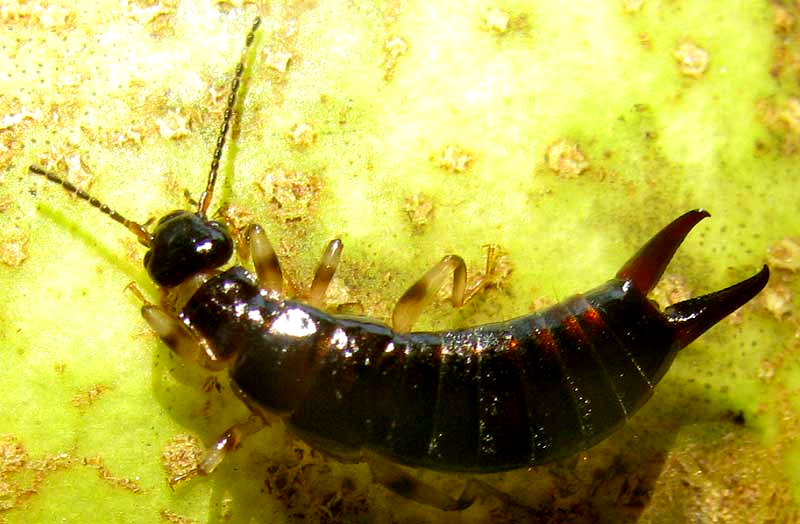Excerpts from Jim Conrad's
Naturalist Newsletter

from the August 12, 2012 Newsletter issued from the woods of the Loess Hill Region a few miles east of Natchez, Mississippi, USA
EARWIGS AMONG PEARS
In the orchard most pears lying in grass beneath trees have earwigs sheltering and presumably feasting inside the pears' woodpecker-pecked holes. The half-inch long (14mm) earwig in the picture above scampered from a hole onto the pear's skin as if to pose for our picture.
About 20 earwig species are listed for the US, with about ten documented in Texas. Learning that, because there's no wing venation to work with, I'd figured I'd never identify the earwig in our picture. However, on the Internet there's a well illustrated identification key to the common US species, which can be downloaded for free at https://www.cdc.gov/nceh/ehs/Docs/Pictorial_Keys/Earwigs.pdf.
That key cued me to notice that the earwig in our picture displays an easy to see and distinctive feature: Its legs and antennae bear dark splotches. That's a field mark for the most commonly encountered species in the US Deep South, the Ring-legged Earwig, EUBORELLIA ANNULIPES. That species is thought to be of European origin but has been spread to many parts of the world, both tropical and temperate.
Ring-legged Earwigs often occur in large numbers, omnivorously feeding on both plant and animal matter. Sometimes they cause modest damage nibbling succulent crops such as lettuce, leaving poop on the leaves. However, they also feed on such diverse prey as caterpillars, beetle larvae, and leafhoppers, so in the overall picture most experts think that the good earwigs do in a garden probably equals or outweighs the bad.
That's a male in our picture. A male's rear-end cerci are more curved and turn more sharply inward at the tip than a female's, which are much straighter. Males also possess ten abdominal segments whereas females possess eight.
Some earwig species bear flimsy, cellophane-like wings, which when not in use are folded under short forewings. Ring-legged Earwigs lack wings, however, so you just wonder how the species has been able to invade so many off-the-road locations.
Earwig cerci, or "pincers," are used to capture prey, defend themselves and to help fold their wings. A little species like the Ring-legged is perfectly harmless to humans, but some species are much larger and can inflict a bit of a pinch with their cerci.